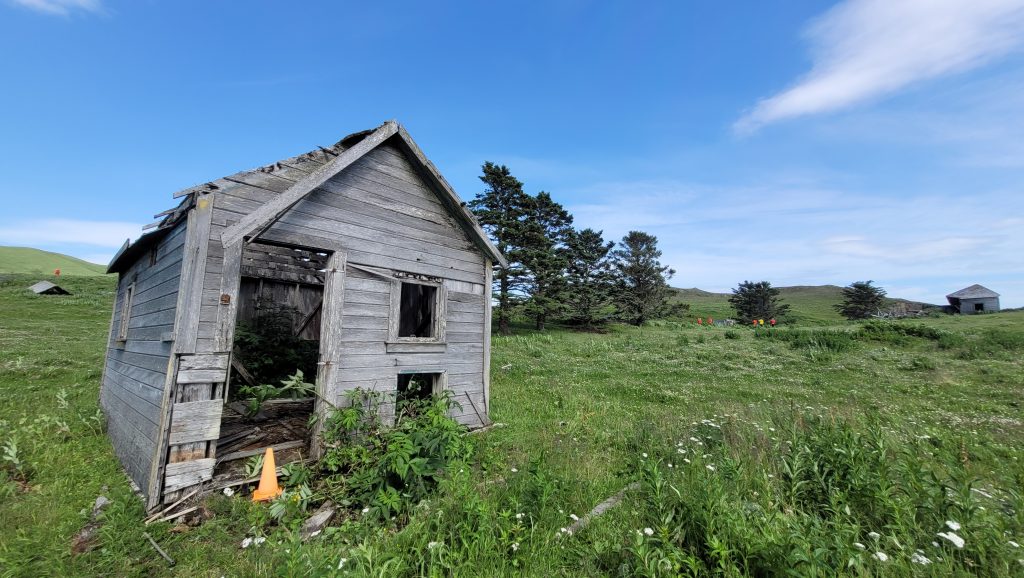The Unga Cow

We are currently making our way back down South from Nome to Vancouver, stopping at all the places we had already visited on our northbound voyage. One of our stops is Unga Island, an almost treeless, 442 sqm island in the middle of the Aleutian Islands. The island boasts one village with a population of: Nil. It’s a ghost town. It had never exactly been a busy metropolis, but the few inhabitants that remained (after its sea otters had been hunted to the brink of extinction, and the local gold mine had been depleted) finally left after the infamous Good Friday Earthquake of 1964 changed the bathymetry (i.e., topography of the sea floor). This rendered the tiny village’s harbour useless, thereby robbing Unga Village of its last remaining source of commercial income from cod fishing.
When we came here the first time, we sent out a scouting boat to see what the conditions were like before bringing out our first guests for a nature landing on a sheltered rocky beach near where the remainders of the village are left standing. „Standing“, in many cases, being rather an optimistic term. The island is constantly windblown, so most of the wooden structures are leaning over, or have long since fallen to the ground.
The wildlife we expected to see included sea otters and seals, plenty of pelagic birds, and foxes: One of the former inhabitants of Unga Village was a fox farmer and set his foxes free when the village was abandoned. We also took our bear spray, just in case. We didn’t expect to run into any bears on the lonely, windswept island, but in Alaska, you simply can’t be careful enough.
What we certainly did not expect was: Cows! They stared back at us with the same startled amazement with which we stared at them.
So, before we returned to Unga the next time, we tried to figure out why they were cows on the uninhabited island. It turns out that they are a type of cattle originally bred in Siberia and brought to the area by Russian settlers in the 18th century. The Yakut cattle, as the breed is called, was selected to withstand the long, cold Siberian winters. It is stockier in build, stores more fat than you average cattle, and has longer intestines to extract every last calory out of the grass it feeds on in the short summers. Both cows and and bulls have horns. Its milk is sweeter than regular cows‘ milk, and the meat is supposed to be very tasty due to the high fat content.
At one point, a number of these cows were released onto Simeonof Island, not far from Unga, to serve as a food reserve for native people should they ever run into a problem – remember the remoteness of these islands. You can’t just send a truckload of fresh produce over when the (non-existant) local supermarket runs out of stock. However, the cows began overcrowding Simeonof and disrupting the ecological balance, so most of them were culled in the mid 1980s. About ten of them were brought to the neighbouring island of Unga – there are different accounts of how they actually got there: One report says they were shuttled to the island on small ships and barges, another says they got a heli lift. However, the ten pieces of cattle let loose on Unga Island thrived there, and today there are anywhere between 30 and 100 of them, staring at back at cruise boat tourists who come to explore their wild, beautiful home.
So that’s the story of the Unga cows!
P.S. By the way, all the info on the Unga cows was researched by my wonderful colleague Erica, and the credit for the photo goes to my equally lovely colleague Chris.

2 Antworten
Mooooooo! Thanks for a lovely blog and super photo.
[…] dorthin das verlassene Dorf Unga Village auf der gleichnamigen Insel (Tier des Tages: Die Kuh! Dazu an einem anderen Tag mehr). Die Aleuten sind vulkanische Inseln, viele davon unbewohnt – die einzige Aktivität auf den […]